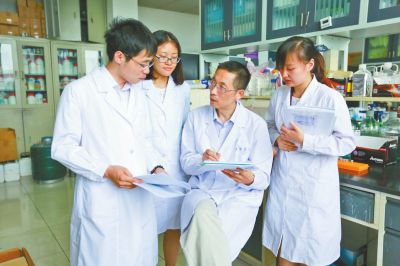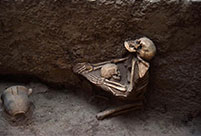

 |
| Prof. Yigong SHI and his team. (File Photo) |
On August 21, the research team led by Prof. Yigong SHI from the School of Life Sciences at Tsinghua University published two side-by-side research articles in Science, reporting the long-sought-after structure of a yeast spliceosome at 3.6 angstrom resolution determined by single particle cryo-electron microscopy (cryo-EM), and the molecular mechanism of pre-messenger RNA splicing.
The achievement not only marks a crucial step forward in the understanding of life, it also marks a mystery which troubled international life science community for twenty years was eventually solved.
Besides the basic biological importance of spliceosome, numerous diseases are related to the dysfunction of spliceosomal regulation or the splicing mistakes. Almost 35 percent of genetic disorder results from wrong splicing, exemplified by unusual expression of alternative splicing that leads to frontotemporal dementia driven by tau mis-splicing. The mutation of key spliceosomal proteins like Brr2 or Prp8 can lead to the Autosomal Dominant retinitis pigmentosa. Some cancers are also associated with abnormal splicing. The findings of the research team led by Prof. Yigong SHI has provided initial answers to some core issues in basic life science.
Since the discovery of “split genes” in 1977, scientists are constantly exploring the molecular mechanism of pre-mRNA splicing. In 1983, Steitz, J.A. group isolated five U snRNPs; in the same year, Sharp, P.A. and Keller, W group set up the in vitro splicing assay independently. Until now, decades of genetic and biochemical experiments have identified almost all proteins in spliceosome and uncovered some functions. Yet, the structure remained a mystery for a long time. The works, primarily performed by Dr. Chuangye Yan, and Ph.D students Jing Hang and Ruixue Wan under Prof. Yigong Shi’s supervision, settled this Holy Grail question and established the structural basis for the related area.
Professor Fu Xiangdong of Cellular and Molecular Medicine in University of California, believes that the capture of the high resolution of three-dimensional structure of eukaryotic cells spliceosome is a great breakthrough in RNA splicing, and the greatest contribution to the basis of life sciences from China in 30 years.
 In pics: album of PLA grand military parades
In pics: album of PLA grand military parades Chinese tanks in National Day Parade
Chinese tanks in National Day Parade In pics: shocking aftermath of Tianjin blasts
In pics: shocking aftermath of Tianjin blasts
 Indomitable Chinese people during WWII
Indomitable Chinese people during WWII
 Awesome Chinese missiles
Awesome Chinese missiles Amazing photos of Chinese Air Force in parade
Amazing photos of Chinese Air Force in parade Striking moments when strategic missiles are launched
Striking moments when strategic missiles are launched Shocking scenes found in 4000-year-old earthquake relic
Shocking scenes found in 4000-year-old earthquake relic Stunning moments of Chinese fighter jets
Stunning moments of Chinese fighter jets Pulling on the river
Pulling on the river Korean tensions won’t take China hostage
Korean tensions won’t take China hostage Are we efficient enough?
Are we efficient enough? ‘Sensitive’ arms exhibited in parade rehearsal
‘Sensitive’ arms exhibited in parade rehearsalDay|Week